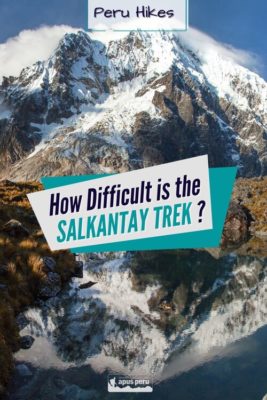If you are considering hiking the Salkantay Trail, you might be asking yourself, “How difficult is this trek going to be?” or “What training should I do to prepare?” Let’s be honest: the Salkantay Trek is not an easy journey.
In this post, we will walk you through everything you need to know about the trek’s difficulty, including what to expect on the trail and how to best prepare. You will learn about the challenges that may arise, tips for acclimatizing to the high altitude, and insights on whether this trek is suitable for you. Plus, we will cover the best time of year to tackle the Salkantay and what essential gear to pack for your adventure.
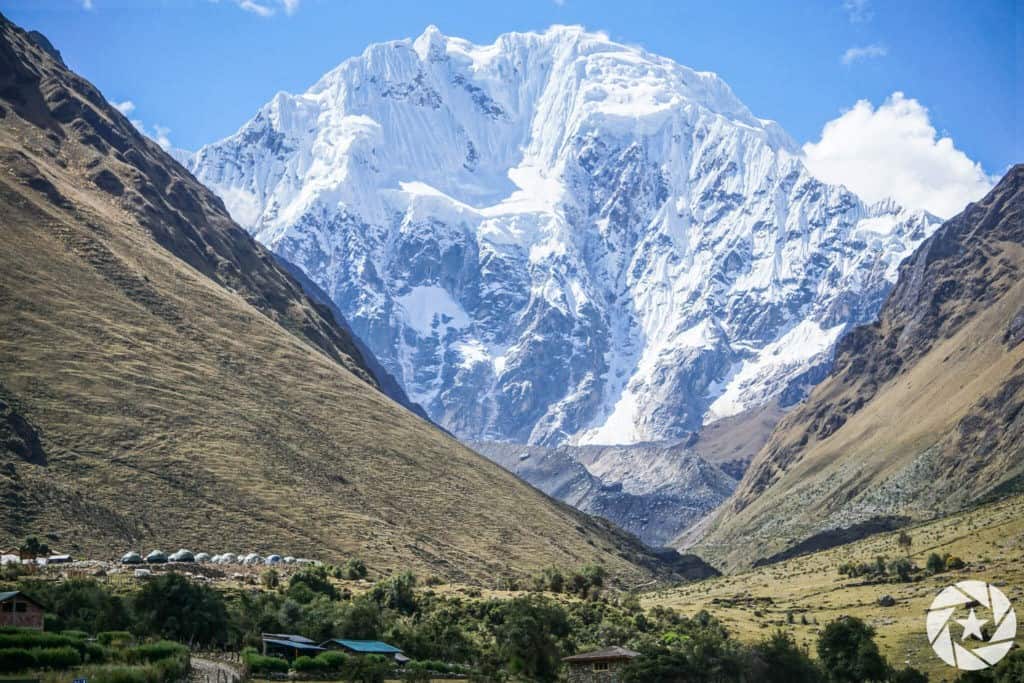
When Inca Trail permits inevitably sell out, many people turn to Salkantay (also spelled Salcantay or Sallqantay) as a good alternative trek to Machu Picchu. So much so that it is now the second-most popular hiking route in the Cusco region!
Salkantay (6271m / 20,574 ft) is located about 60km (40mi) northwest of Cusco city. As the second-highest peak in the Vilcabamba mountain range (after Ausangate), Salkantay mountain is an important apu, or mountain god, in the Andean region.
The name salkantay comes from the Quechua word sallqa which means wild, savage or invincible. The ancient Inca associated Salkantay mountain with weather, rain and fertility.
Fantastic alpine scenery is the true highlight of Salkantay. The Salkantay trek to Machu Picchu takes you over soaring mountain passes, past snow-capped peaks, and down into the Andean jungle. It’s an incredible journey through changing scenery as you reach heights of over 4600m (15,092 ft) before descending to just 1000m above sea level.
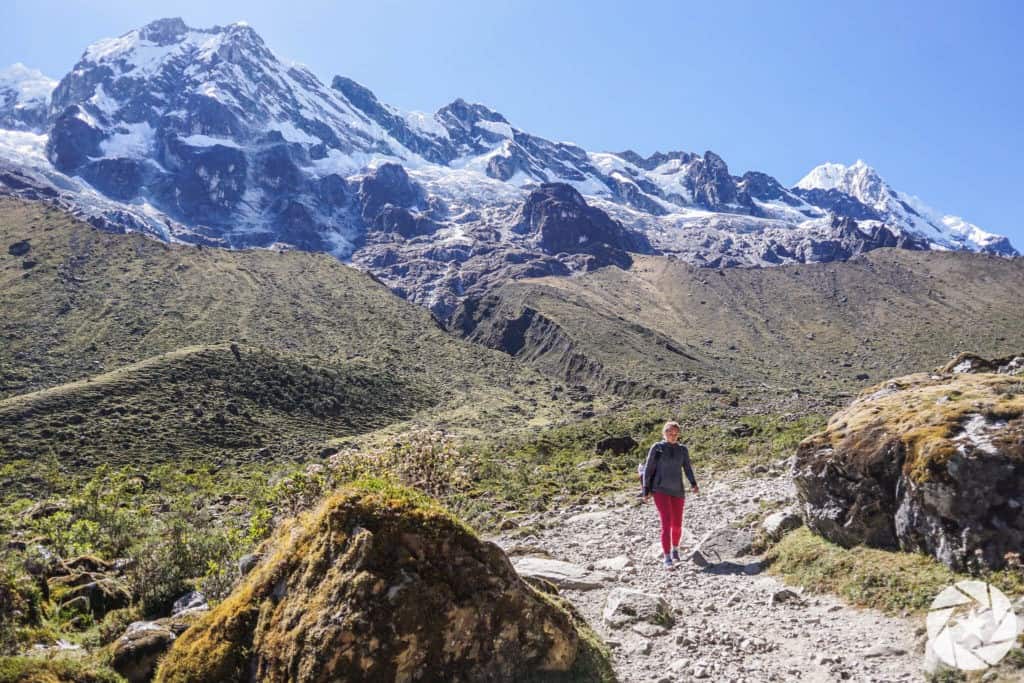
At Apus Peru, we offer two Salkantay trekking itineraries, a 5 day trek and a 4 day trek. Both are designed to keep you slightly out of sync with the crowds, and show you some of the surrounding highlights that other trekking companies miss.
They differ in their difficulty levels: while the 5 day trek is moderately difficult, the 4 day trek is a challenge reserved for only the fittest hikers.
No matter which itinerary you choose, the Salkantay trek is far from easy. We don’t consider it to be the hardest trek in the Cusco area, but the long days, steep ascents and descents and the high altitude make both routes difficult.
Remember all treks in the Cusco region are challenging for most people due to the high altitude and steep mountain trails!
Our 5 day Salkantay trek is the route that most trekkers opt for. Although longer, it is not quite as difficult as the 4 day hike. We consider it to be moderately difficult overall – 3 stars out of 4.
Understanding our trek difficulty rating system
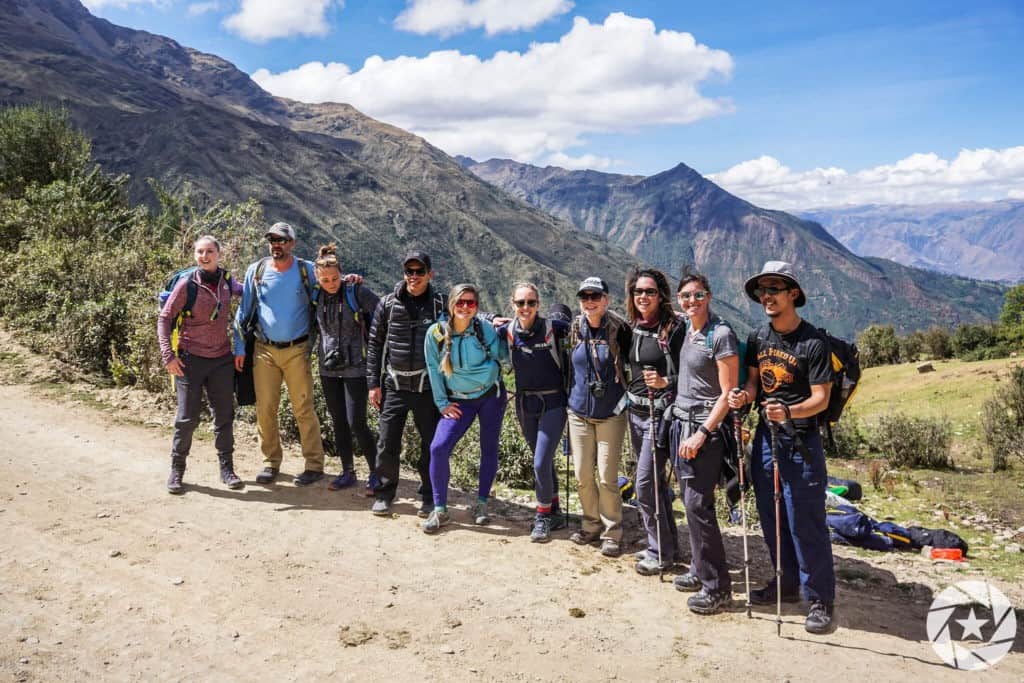
Unlike most Salkantay treks (which start in Mollepata), we start hiking at Soraypampa and take a special round-trip visit to Lake Humantay on Day 1. Although it’s a moderately difficult uphill climb – especially the second half of the 1 ½ hour hike – visiting the stunning Lake Humantay is a real treat for Salkantay trekkers!
We then return down the same path. The uphill hike is strenuous and can be difficult for many; on the way down, the steepness of the trail can be hard on the knees. If you have knee trouble, this may not be a good hike for you. No matter what, we recommend you bring or rent trekking poles.
Day 2 is without a doubt the hardest part of the Salkantay trek. The day begins with a 3h switchback hike to the highest point on the trek, the Salkantay Pass, located at a breathtaking (literally!) altitude of 4600m (15,092 ft).
If you’re thinking, “that doesn’t seem so bad,” remember: that’s 400m (1312 ft) higher than Dead Woman’s Pass (Warmihuañusca), the highest point on the Inca Trail.
You must be fit and mentally prepared to hike up to 4600m.
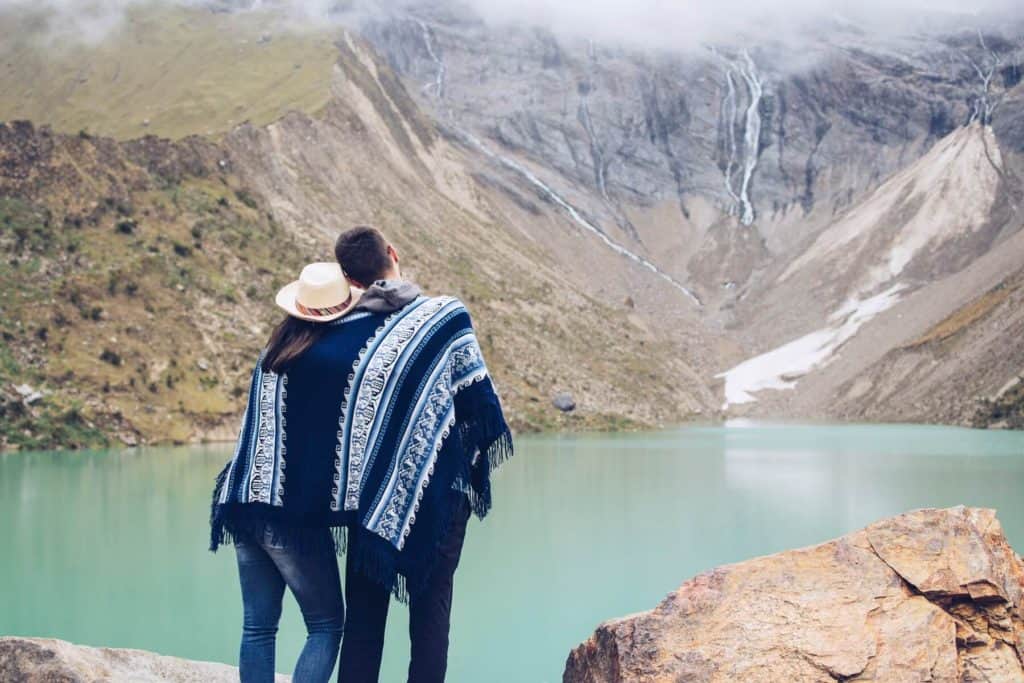
The third day on the trail features a slow, gentle descent through the semi-tropical Andean jungle over the course of 4.5 to 5 hours. A 15 minute car ride then takes you to the Lucmabamba campsite (or, you can walk along the road for an extra hour, but it can be unpleasant due to passing traffic and loads of dust).
Time permitting, in Lucmabamba you have the chance to learn about traditional coffee-making with a member of the local coffee cooperative – and indulge in the results!
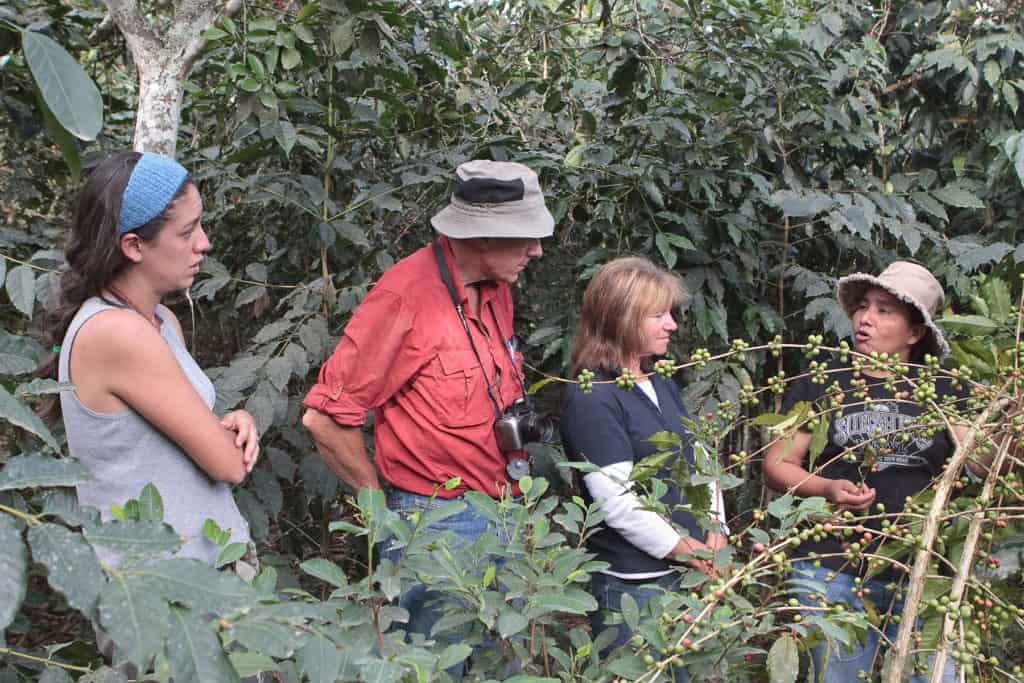
On Day 4, it’s a tough 3 hour hike straight up through the jungle-clad mountainside to Llactapata. You climb nearly 800m from Lucmabamba to Llactapata, and even though you are now at a kinder altitude, it’s hotter and this can be tough.
For us, Llactapata is the perfect introduction to Machu Picchu! It is an interesting Inca ruin with a fascinating perspective across the mountains to Machu Picchu, and an unforgettable way to start your visit to the ancient Inca citadel!
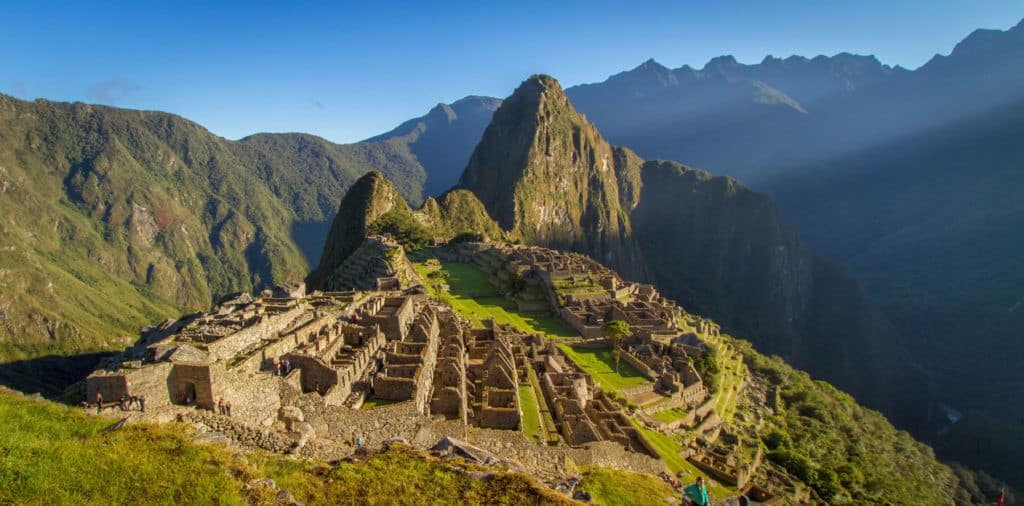
Your guide’s explanation will get you thinking about how incredible the Incas really were. One of the most fun facts about Llactapata (also spelled “Llaqtapata”, and meaning High Town in Quechua) is that it was “discovered” by Hiram Bingham prior to his first visit to Machu Picchu. His notes weren’t accurate, though, and the ruins were actually lost to the world until modern day explorers Hugh Thompson and Gary Ziegler once again located Llaqtapata in 2003.
From Llactapata it’s a 2 hour trek to Hidroelectrica via a steep, muddy track (the last 3km are along a road). The hike back down is another very steep challenge as you descend a whopping almost 1000m. This is definitely a time when trekking poles will be helpful!
Then, you have the option to hike another 2.5 hours, or, take the train to Aguas Calientes. (The cost of the train ride is included in the price of your trek!)
After a night in comfortable hotel, Day 5 is spent visiting Machu Picchu, before returning to Cusco.
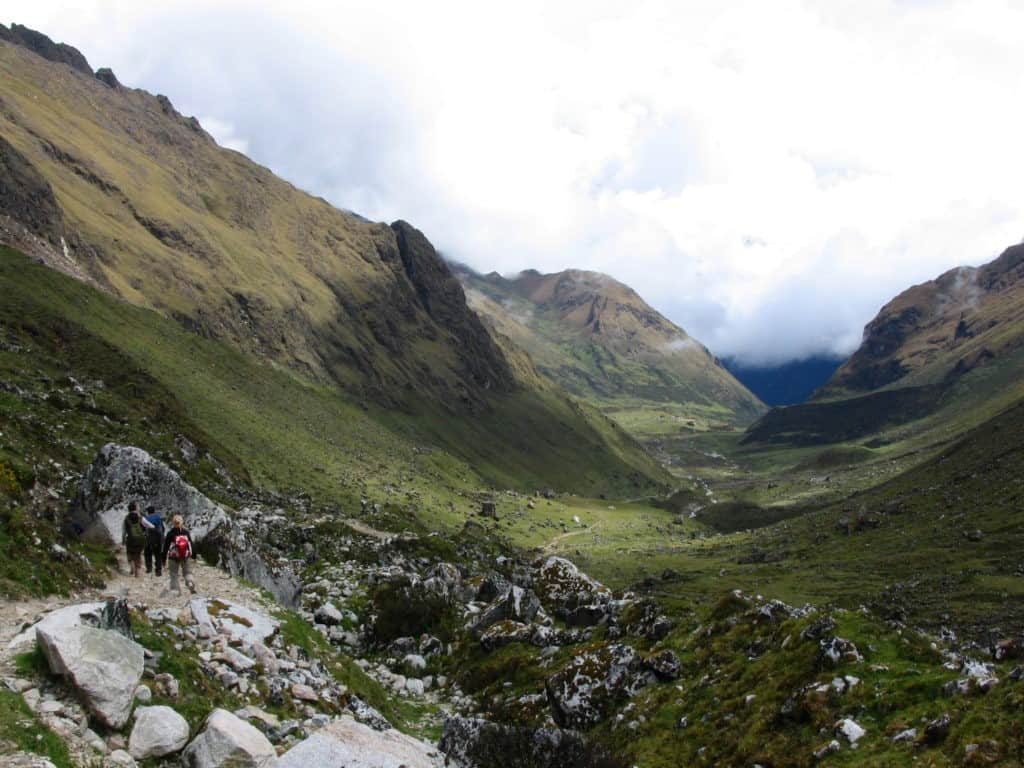
For those wanting more of a challenge we also offer a 4 day Salkantay hike for the extra fit and hardy. This trek includes a difficult first day via Chuñuna and a very high altitude campsite on the first night (4490m / 14, 731 ft). You must be well-acclimatized to do this difficult Salkantay hiking adventure!
This option takes what is normally a 5 day trek and condenses it into 4 days, while also adding a unique & challenging detour on Day 1. The first day in particular is a very long day of hiking (8-9 hours for most hikers) with a steep, challenging switchback climb leading up to a very high altitude campsite.
This trek requires a solid level of fitness and mental preparation, as well as at least 3 days of acclimatization prior to beginning.
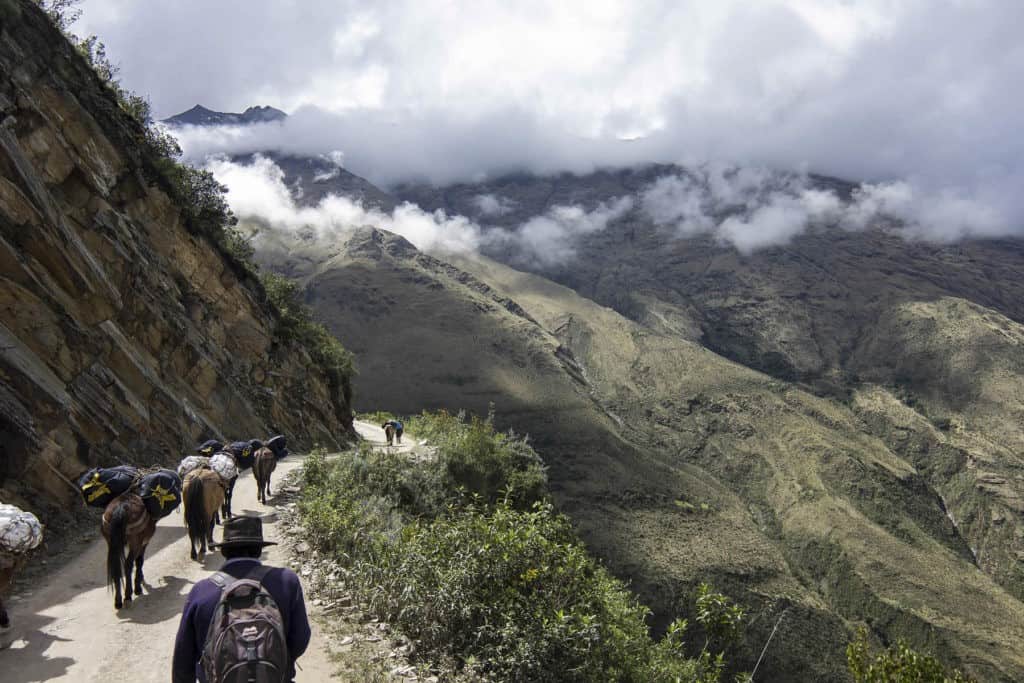
One thing that might make the Salkantay trek more difficult for some – or certainly less comfortable – is dust. This is particularly a problem during the dry season.
Unlike the Inca Trail – where porters carry the bulk of the equipment – on the Salkantay trail, mules do the heavy lifting. And considering how busy the Salkantay trail is, this means the trail is often full of long mule trains – on their way to the next campsite, or returning home after accompanying a group – kicking up loads of dust. It’s worst on the second day.
Many people comment that the dust – and manure! – add to the discomfort you can experience on the trek. Some of this difficulty on the Salkantay trek can be avoided by going with a company like Apus Peru which takes you off the beaten path – meaning you’re likely to run into fewer of these mule trains.
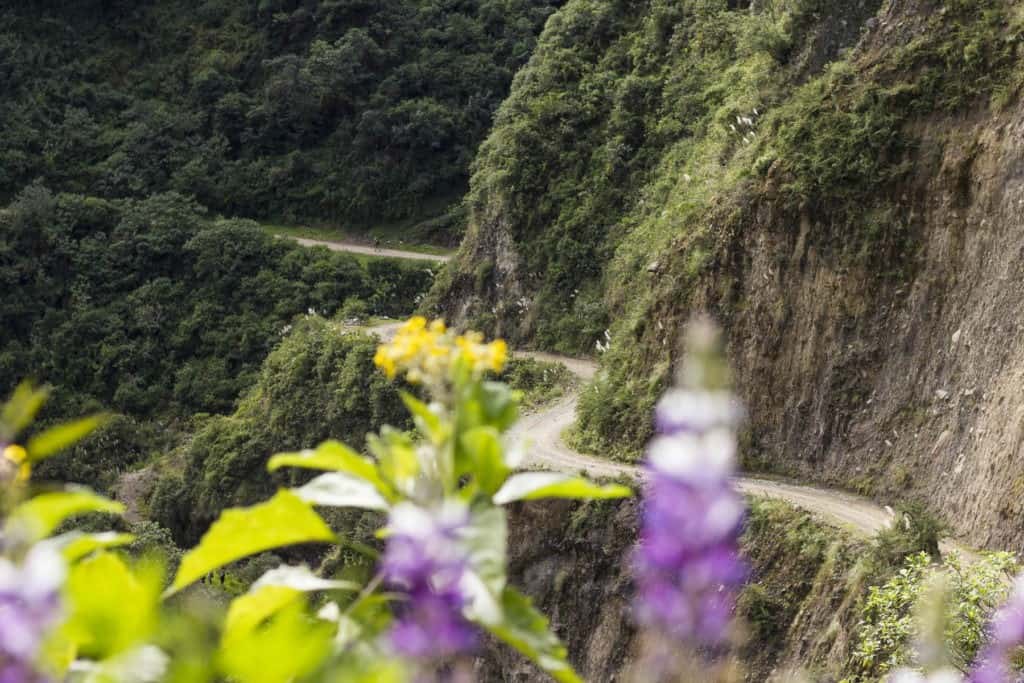
If you’re young and fit and normally work out a few days a week, you are likely to find the Salkantay trek difficult. Those who are less fit or who are unaccustomed to hiking should most definitely train for the Salkantay trek.
In general, we recommend beginning a fitness training program prior to departing. If all you have is one month to train that will be a good start, but 6 to 8 weeks of training prior to trekking is even better. If your fitness level needs a real overhaul in order to do the hike, you should consider a 3 to 4 month training plan for Salkantay.
This pre-hike training might include spending time at the gym, or doing some day hikes at home before you leave. You should begin with shorter, 1 hour hikes, and work your way up to as much as 15km per day. Include uphill walks, or even better, try to hike in the mountains if you live in a mountainous area.
A rigorous fitness training program is best done in consultation with qualified medical and fitness professionals who can guide you. What exactly this will entail depends on each person and their own abilities.
Any training regimen you undergo should be tailored to you according to your current fitness level and prior experience. Our general advice: the fitter you are, the easier the hike will be!
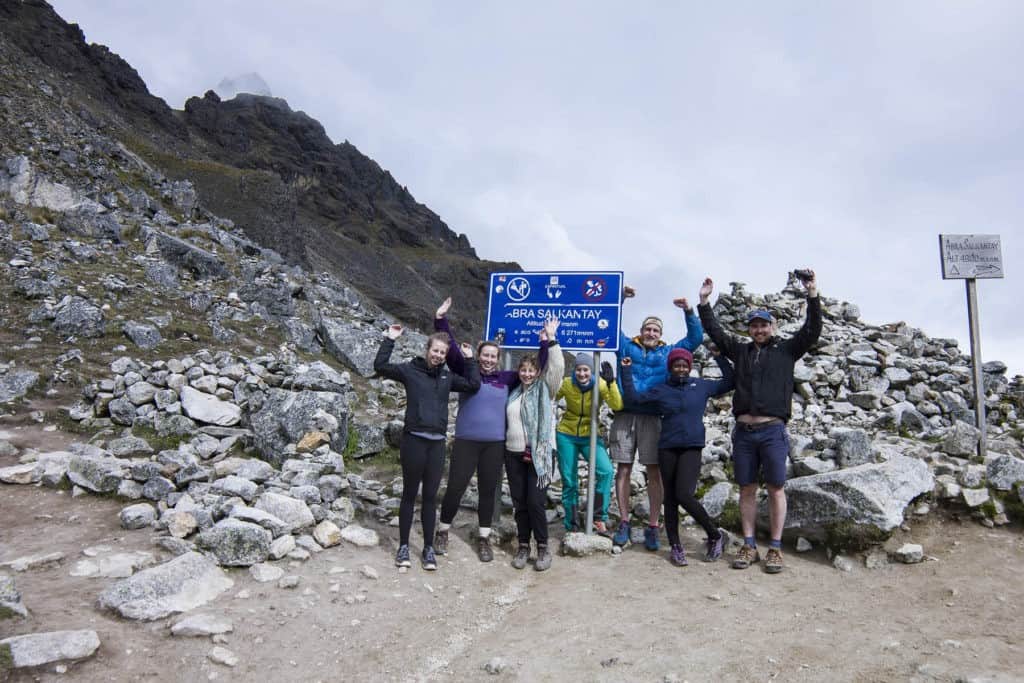
High altitude is one of the things that makes the Salkantay Trek difficult for most trekkers. Even if you are accustomed to long-distance trekking, if you are not properly acclimatized you will suffer on this trek.
The best way to prepare yourself for the altitude is very easy: spend time at a high-altitude place like Cusco. In an ideal world, 3-4 days should give your body an excellent chance to acclimatise. If the altitude makes you feel sick, you will have plenty of time to adjust and recover before beginning the hike. Feeling sick on an already difficult hike is not fun.
In addition, be kind to your body while acclimatizing. This means eat healthy food, stay away from alcohol, and drink plenty of water or herbal tea – the locals recommend coca tea to help with the symptoms of altitude sickness! Staying healthy and treating your body well helps it deal with the extra pressures that altitude create.

For more tips about how to prepare for the Salkantay trek difficulty, check out our page on Altitude and How to Acclimatize.
You’re in luck! We know the Salkantay trek is hard. That’s why we send an emergency riding horse on all of our alternative treks in Cusco. If you get tired from walking during a particularly long day, if the steep trails are too difficult, or if you’re not feeling well because of the altitude, you can ride the emergency horse for a while to help make things easier for you.
The difficulty of the Salkantay trek doesn’t exactly change depending on the time of year you go, but you are likely to face different weather conditions and different risks depending on when you go. This doesn’t make the Salkantay trek harder, necessarily, but certain conditions can make the trek more uncomfortable or more risky.
At Apus Peru, we only offer the Salkantay trek during dry season (April-October). The dry, winter months (May-August) are the best time of year to do the hike anyway. This is the time of year with the least amount of rain – usually none! Rain makes a difficult trek like Salkantay so much more unpleasant.
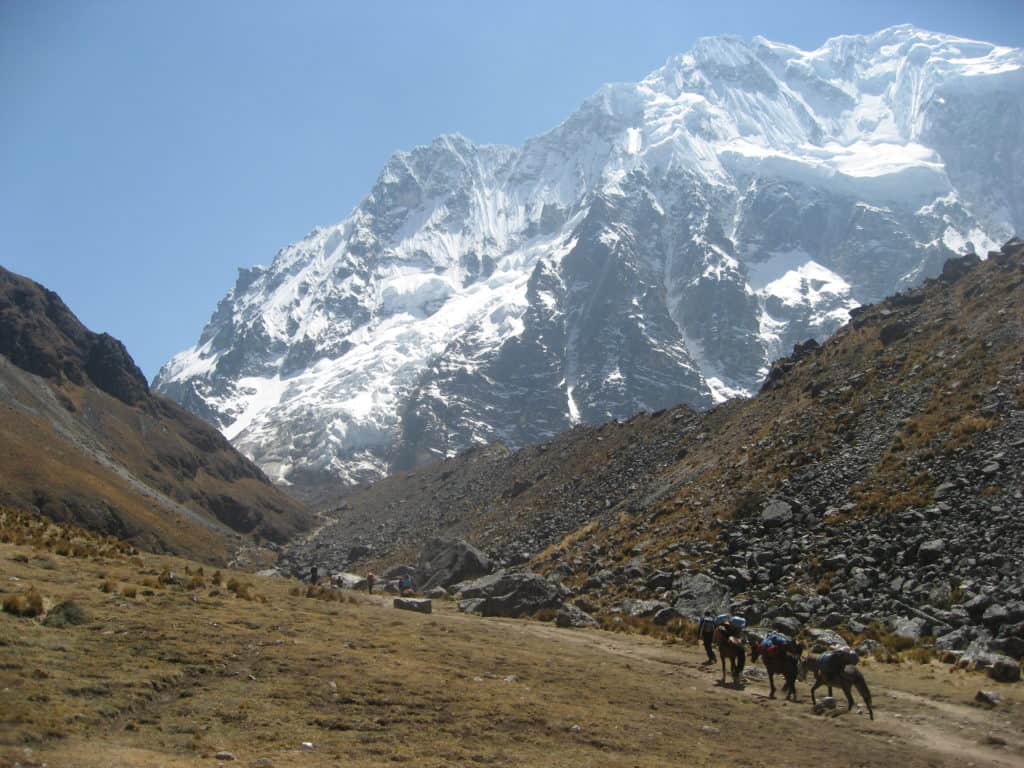
The downside to the winter months is that, unsurprisingly, they are also the coldest months of the year. Night time temperatures – especially at the first campsites – can fall below freezing. You must be well-prepared with sufficient warm clothing and a really good sleeping bag! As this is peak trekking season, too, the trail will most certainly be teeming with fellow hikers.
The Salkantay hike is not available during the rainy season (November to March). During this time, the trail is not safe. Heavy rains can cause mudslides, or wash away the trail entirely. There is also a risk of snowfall on the pass and hiking in snow is no fun, especially if you are not properly prepared for this kind of cold.
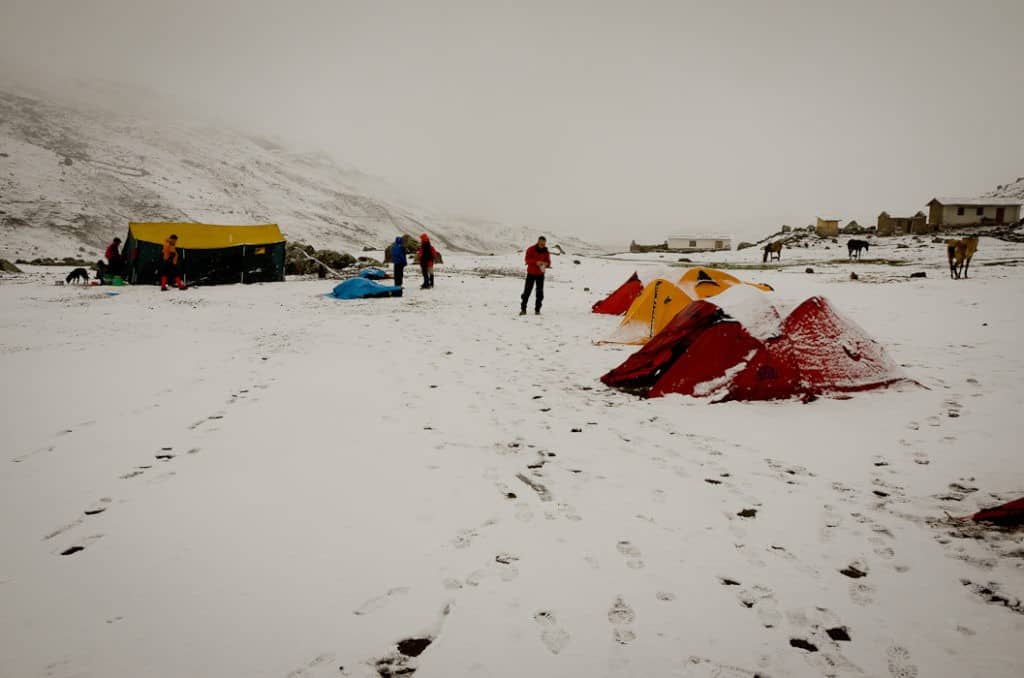
Even the shoulder seasons (April, October) are touch-and-go. Once the rains start, the Salkantay Pass can be shrouded in clouds, and foggy. This means that the stunning high alpine scenery – a real highlight of the trek – is hidden. Imagine coming all the way to Peru, getting through a difficult hike, only to not be rewarded with the stunning views that you were dreaming of.
Read more about the best time to hike and take note of our wet season trekking policy. If you book a trek during the rainy season, we reserve the right to change or cancel your trek on short notice, if weather conditions deteriorate.
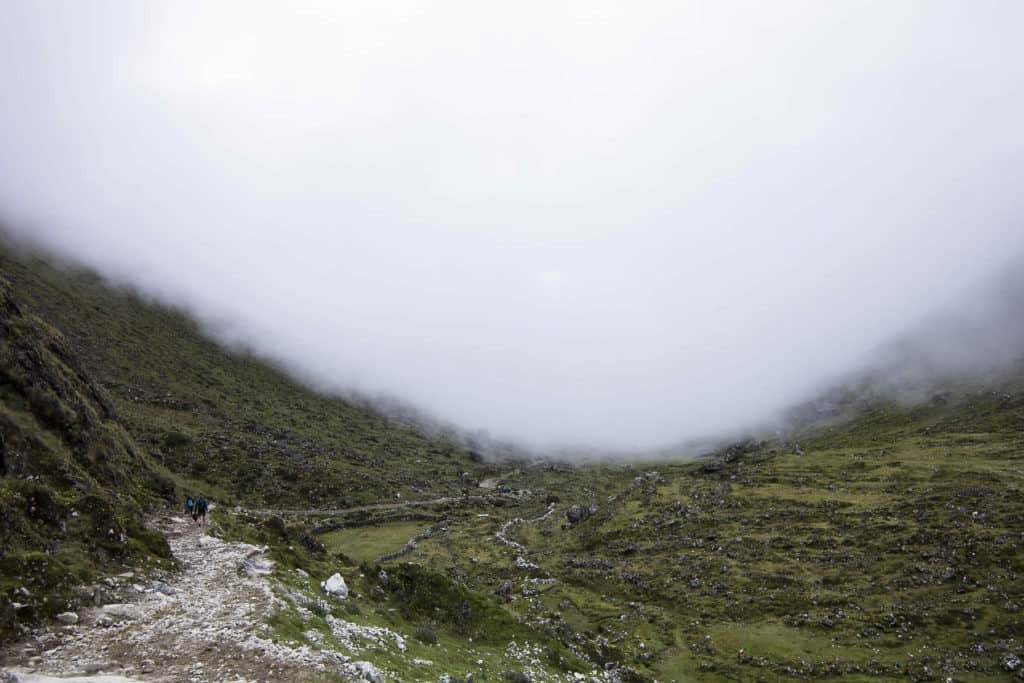
Any trek will feel less difficult if you have the right gear! For Salkantay, layering and flexibility are key. You will be hiking through some very different climates – from cold alpine terrain to warm, semi-tropical trails – so it’s important to be prepared for all kinds of weather.
Quick-dry, convertible pants are a great choice. They offer a maximum range of motion, handy pockets for storing things while you hike, and the lower portion zips off so you can hike in shorts when it gets hot. Pair these with a thermal base layer underneath on the cold days and you’re golden.
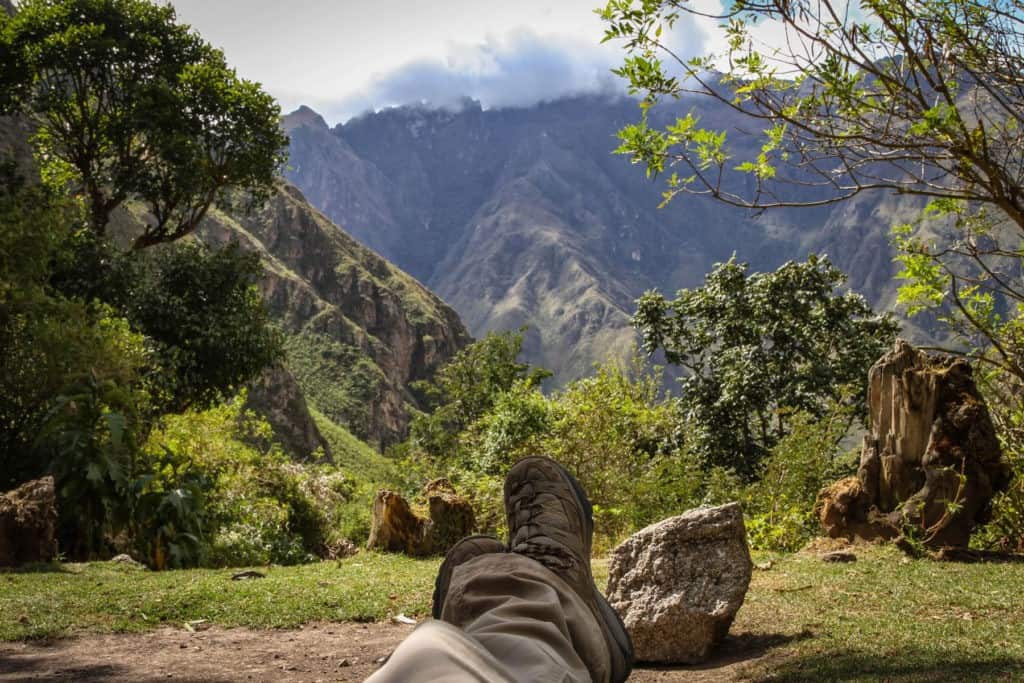
Waterproof trekking boots with a high top are the best hiking boots to take on a trek like this. If you don’t want to invest in specialist trekking boots like these, a solid sports shoe or cross trainer will do in a pinch.
You could also invest in hiking shoes. What’s the difference between hiking boots and hiking shoes? Hiking boots are generally more durable, very waterproof, and they have ankle support. Hiking shoes, on the other hand, don’t have ankle support, might only be water-resistant instead of waterproof, and typically aren’t constructed to last as long.
What about camping equipment? We provide just about everything you need for the trek to make sure you are adequately protected and comfortable. On your trek, you will stay in 4-season North Face tents and we even provide basic foam mattresses. For a bit of added comfort, you can rent a Thermarest inflatable mattress from us, and even an inflatable pillow!
Want even more comfort? Check out our Comfort Camping upgrade!
Sleeping bags are not included in the price of your trek, as many people prefer to use their own. We DO have them available for rent if you don’t have one. We have “standard” and “deluxe” sleeping bags available. The difference has to do with how warm they are: the standard sleeping bag is good to -5°C, while the deluxe sleeping bag is good to -15°C.
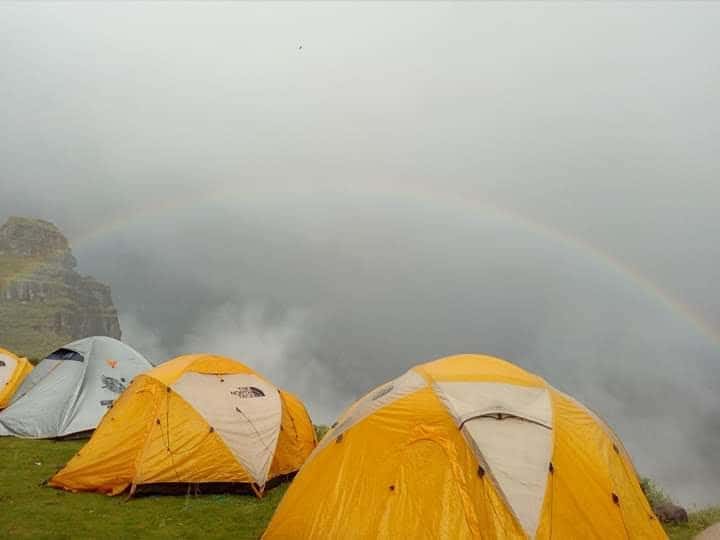
For a trek like Salkantay, you will likely prefer a warmer sleeping bag, as the first night or two can be very cold. By the last night, you may be sleeping on top of it, though! You can also take a sleeping bag liner (we provide these when you rent a sleeping bag from us) and use that on the warmer nights.
Other items to make sure you carry in your daypack include:
|
|
|
You will probably start the day wearing your thermals, but you may be de-layering by the end of Day 2, or certainly during the course of Day 3.
We recommend carrying a bandana for the dust. Alternatively, a sarong or a large lightweight scarf is great to wrap around your head and neck to keep the wind and dust out. Plus, it can be used to sit on, or even as a towel!
For a complete list of packing suggestions, see our comprehensive recommendations on What to Bring. You can also check out our blog How to Prepare for a Trek in Peru.
It’s not a race. If you push yourself, the trek will seem harder. Our guides are well-trained and are experienced leading groups of all different abilities and speeds. You do not have to feel like you need to stay at the head of the pack all the time. And don’t forget – the emergency horse is there for you when you need it.
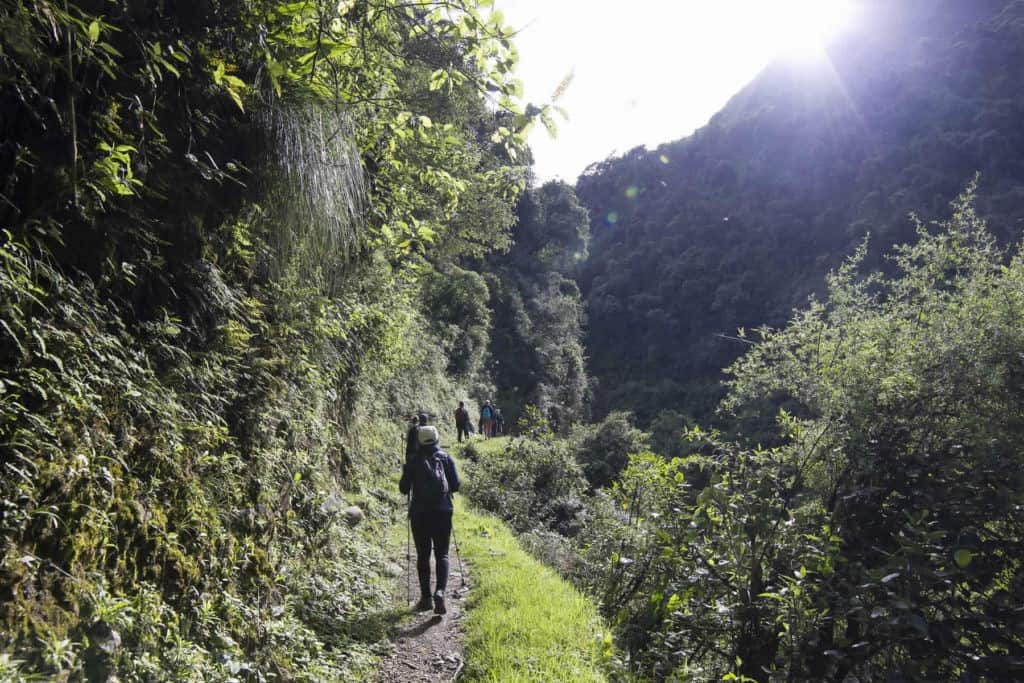
This is especially important when going uphill, or while hiking at the higher altitudes along the route. There may even be times when you take one step, then rest, another step, then rest. This is fine. Salkantay is a hard trek! But you will feel so proud of yourself for finishing it.
If you plan on purchasing new hiking boots for this trek, we recommend wearing them around the house and while you’re out training for the Salkantay trek to break them in. At least two weeks of frequent wear is needed to make sure your feet are totally accustomed to them and that your hike will be comfortable.
You do not want to get blisters on the trail! (But if you do get them, moleskin or second skin is helpful, so you might want to keep some in your day pack.)
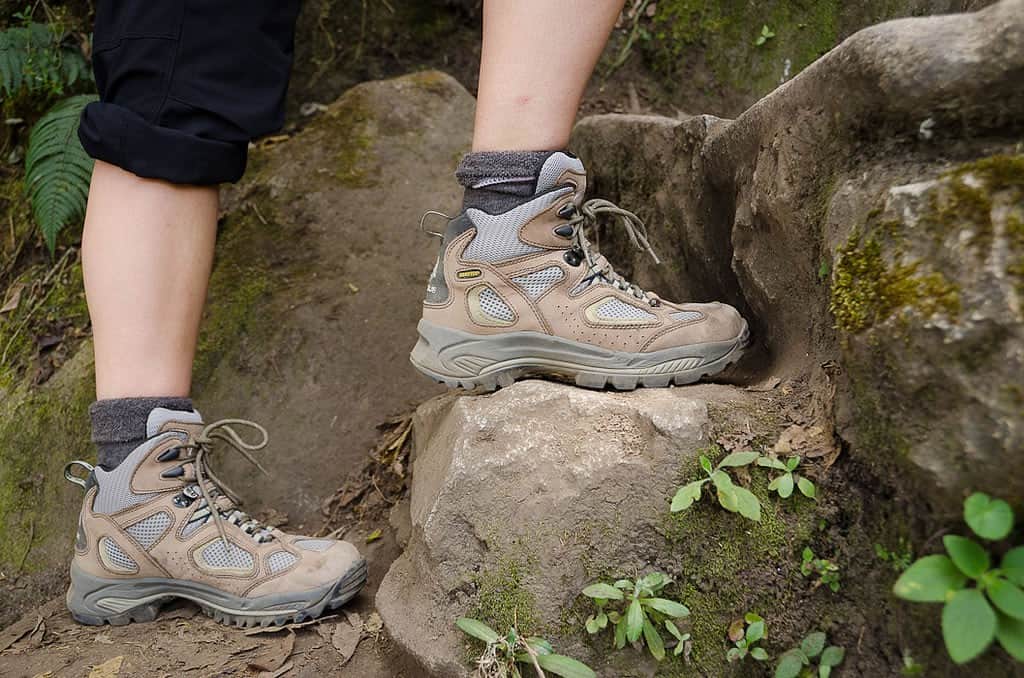
Dry feet are happy feet! If your feet get wet on the trail, you will be very thankful for that extra pair of socks at the end of the day. They are light and easy to carry and an extra pair can warm up your toes at night as well….or even your hands!
There are difficult uphill and downhill sections on the Salkantay trail where walking sticks can come in handy. Contrary to what you might think, trekking poles are not for older or unstable hikers; they are for people who like a bit of support when hiking. If you have your own, bring them along. Alternatively, you can rent trekking poles from us. Note: Walking sticks cannot be taken into Machu Picchu!
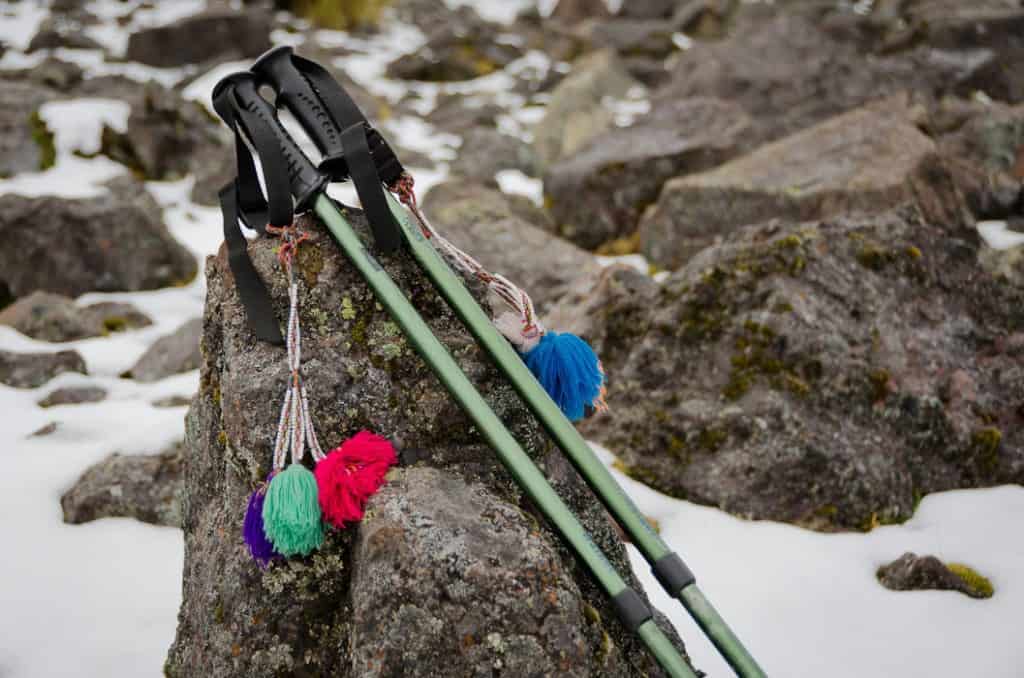
We provide plenty of snacks during the hike, but it never hurts to have a little extra on hand. Sweets in particular give you energy and can make difficult passes seem easier
For more trekking tips to make a difficult Salkantay trek a little bit more manageable, check out our Trekking Tips web page.
No. The trail is well-marked, so many consider Salkantay one of the treks you can complete on your own. Certainly, if you’re an experienced backpacker used to doing multi-day hikes in the mountains by yourself, you will probably be fine.
Cost-wise, there is no entry fee to Salkantay, so your main costs are transportation and food, as well as the visit to Machu Picchu. You will also have to pay a nominal fee to use each of the campsites.
Machu Picchu can be very costly. At a minimum, you will need to count on paying the entry fee to the site, guide for the tour,* and the bus up and down. If you also plan on hiking Huayna Picchu, that is another fee. Plus, if you don’t hike from Hidroelectrica, there is the cost of that train, plus meals and accommodation in Aguas Calientes the night before your Machu Picchu visit. And of course, the train and bus ride back to Cusco.
*Note: as of 2017, it is compulsory to hire an official guide to visit Machu Picchu. If you are an independent traveller these guides can be contracted in Aguas Calientes or even at the gates of Machu Picchu.
Of course, hiking on your own means that you have to carry ALL the equipment by yourself, too, adding to the difficulty of the trek: tent, sleeping bag, mat, camp chair, cooking stove, dishes, food….in addition to enough clothing and other gear to make sure you are prepared for the changing trail conditions. If you decide to hire a mule and muleteer to help carry these items, that will add to your cost as well.
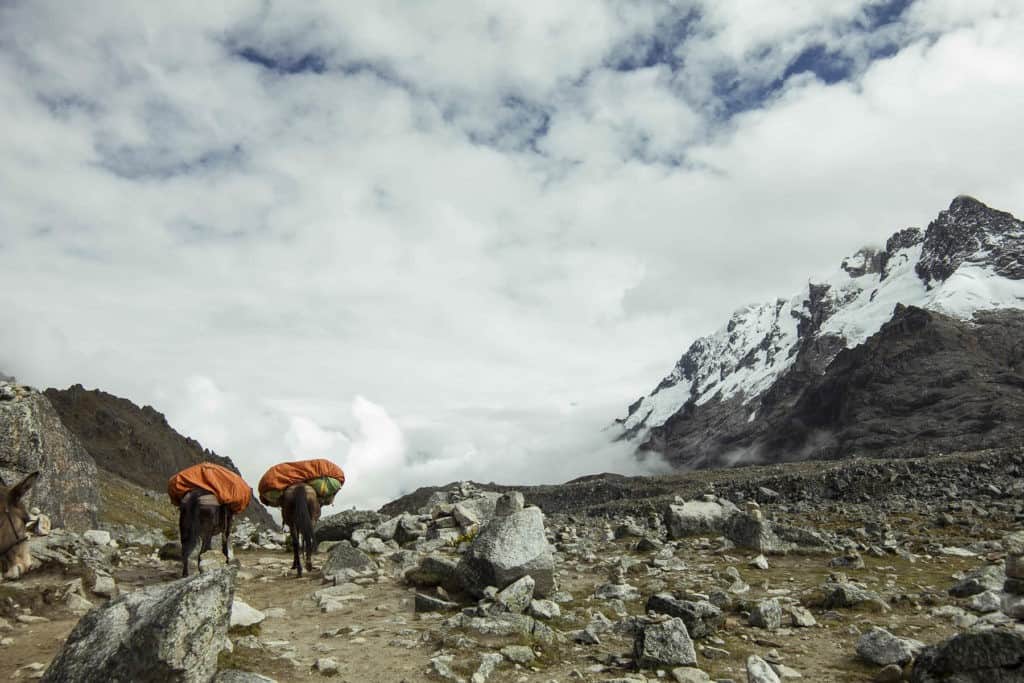
There are also certain risks to be aware of. Especially during the rainy season, there is a chance of rockslides and trail wash-outs. There can even be snow at the higher altitudes. Theft is also a concern at some of the busier campsites, especially as Salkantay is one of the most popular treks, and unregulated.
For those reasons, and generally to make your life easier, we think it’s best to go with an organized tour. We offer private treks, so if a big group hike is not your thing, we’ve got you covered while still taking the stress out of planning a difficult trek in an unfamiliar place.
You can book your trek any time, though we recommend booking as early as possible to ensure your spot, obtain optimal train times and also to give yourself plenty of time to train.
The Salkantay trail itself is not subject to occasional closures – unlike the Inca Trail, which is closed every February for regular maintenance. Also unlike the Inca Trail, you don’t have to worry about permits selling out, because Salkantay is not regulated by the government.
However, during peak tourist season, tickets to Machu Picchu – especially the extra hikes, Huayna Picchu or Machu Picchu Mountain – are in danger of selling out if you wait too long to book.
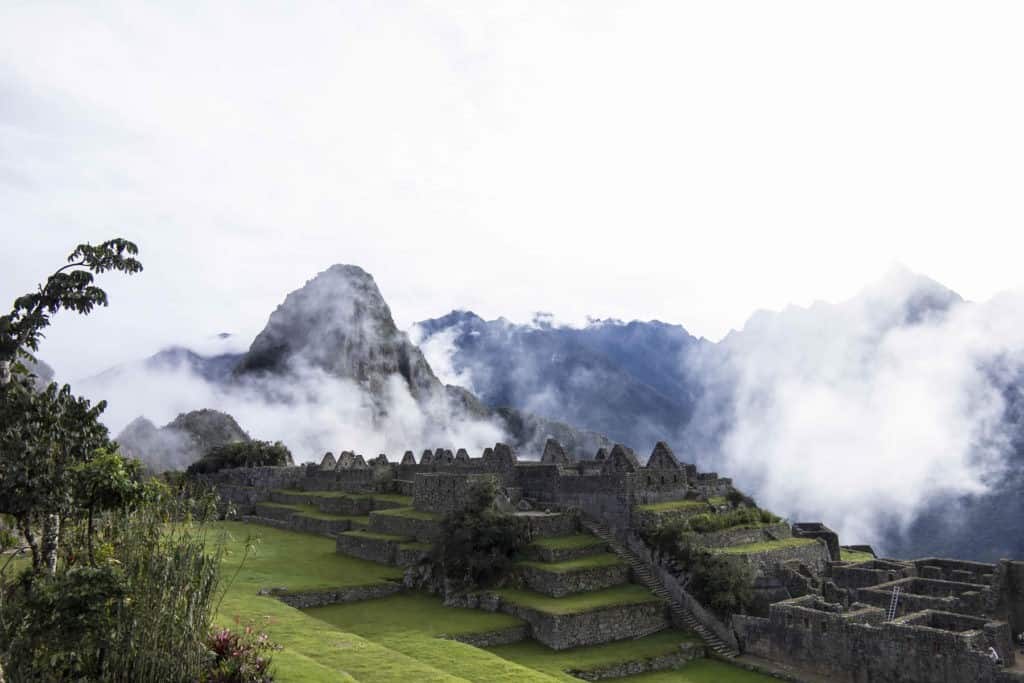
The other thing to worry about are the trains. For the best train times leaving Aguas Calientes – ensuring that you get back to Cusco at a reasonable hour – you should plan to book early. (However if you don’t mind arriving back to Cusco near midnight then you can get away with last-minute booking!)
For those reasons and for your own peace of mind, we recommend booking as early as you can.
We also encourage booking early as part of our commitment to responsible travel. Booking early means we can give our field team plenty of notice, which helps them plan. We prefer to let our guides and other field staff know their trekking schedule at least a month in advance.
READY TO BOOK? Check out our Salkantay itineraries below, then submit an inquiry form or email one of our Trek Experts directly:
For some people, the fact that Salkantay is such a busy trail makes it harder. Either the hustle and bustle of so many fellow trekkers makes it harder to enjoy the scenery, or the concern about over-tourism makes it difficult for someone to choose the Salkantay trek.
The Salkantay trail is a very popular trek, and the second-busiest in the region. Hundreds of trekkers hike the trail each day, and the most popular campsites can be crowded and noisy. The trail is already showing the effects of the lack of regulation. Compared to the Inca Trail, which is strictly regulated by the Peruvian government, there is no oversight of the Salkantay trail.
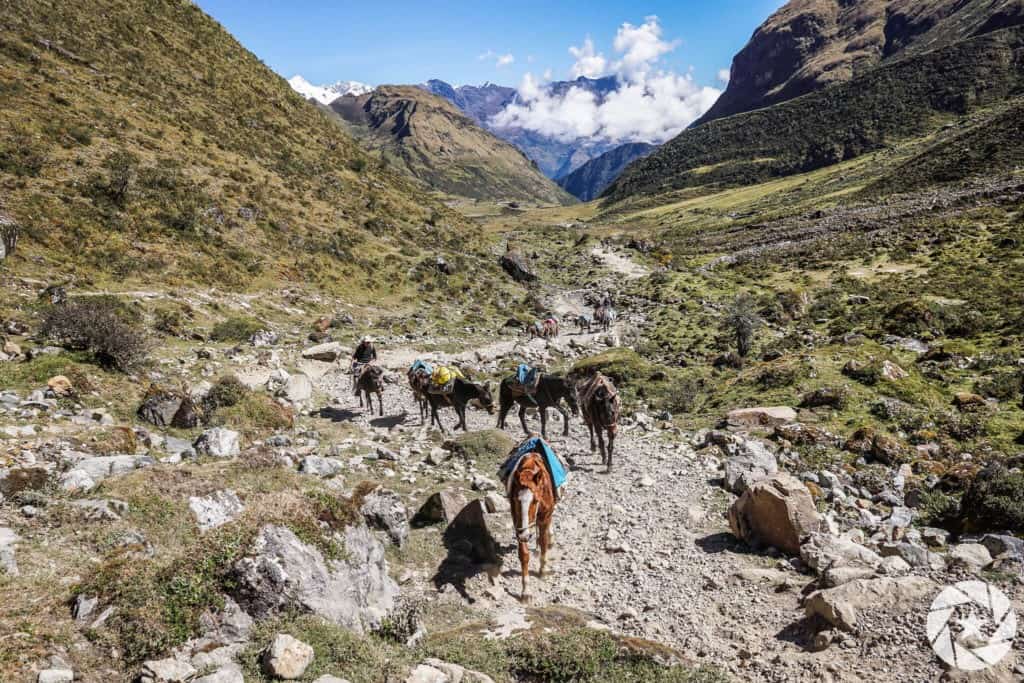
Given its popularity, it’s prone to wear and tear, and litter left by careless hikers. As a responsible trekking company, we follow “leave no trace” principles, aiming to minimize our impact on the environment. Not only do we pack in and pack out absolutely everything, the trekking tours we provide are “off the beaten path” in an effort to limit our environmental impact.
In addition, we started a program called Handy in the Andes. We organize monthly “clean up treks” where our passengers help out by picking up trash left by others, and we give them a discount on their trek for lending a hand! It’s just one of the small ways we’re trying to do our part for the environment.
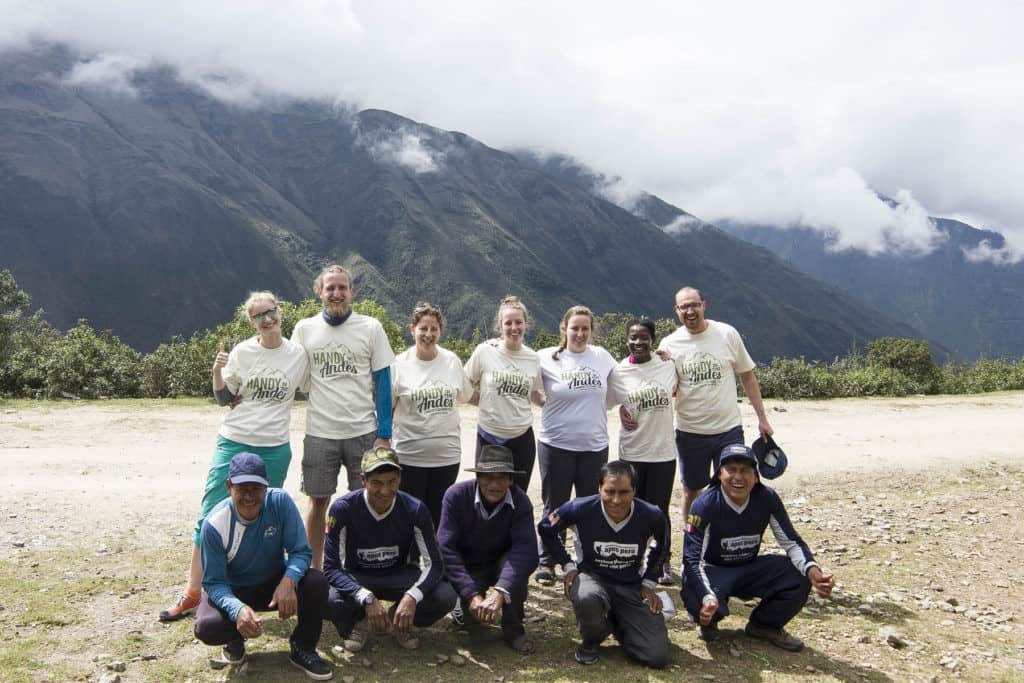
Planning a trek in the Andes? If you are intrigued by the colorful landscapes of Rainbow Mountain, don’t miss our post on Exploring the Rainbow Mountain Hike. For a truly off-the-beaten-path experience, Choquequirao is often hailed as the best hike in Peru. We’ve got all the details on Choquequirao Trek Difficulty and how many days you’ll need to conquer this incredible route.
As we’ve hopefully shown, Salkantay is a difficult trek, but with the right training and preparation, it is totally doable. The stunning mountain views, fascinating Inca history, changing landscapes and opportunity for hands-on learning make this trek one of the most unique and most rewarding in the Cusco area. If you’re up for the challenge, we encourage you to give it a try!
Are you ready for phenomenal trekking adventures in Peru? Start by exploring our guide on The 25 Best Hikes in Peru to uncover some of the country’s most breathtaking routes.
